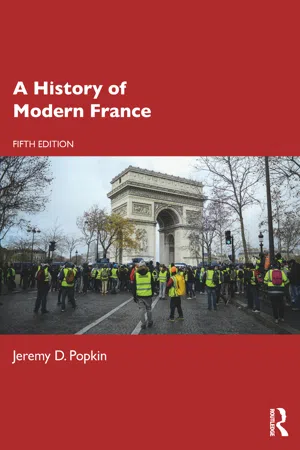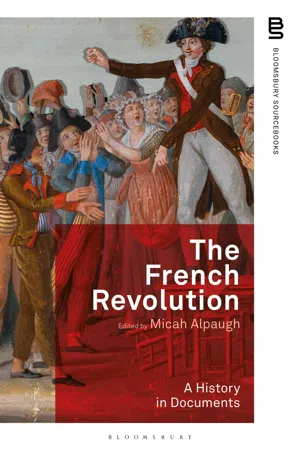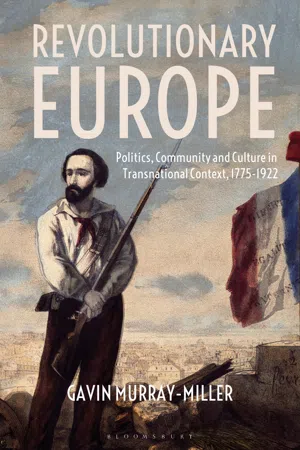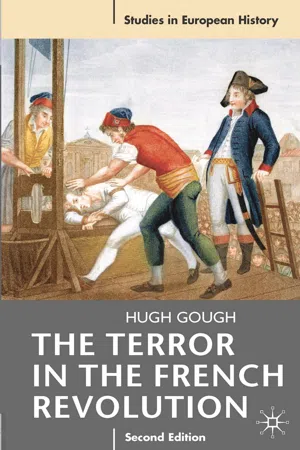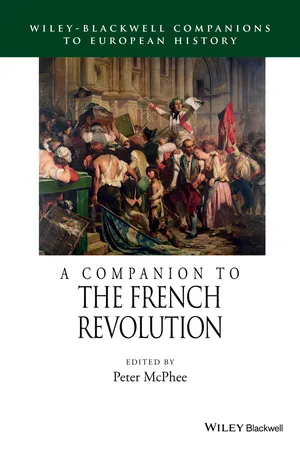History
Radical Phase of French Revolution
The Radical Phase of the French Revolution, also known as the Reign of Terror, was a period from 1793 to 1794 characterized by extreme violence and political upheaval. Led by the radical Jacobin faction, it aimed to eliminate opposition to the revolution and establish a more egalitarian society. The period saw the execution of thousands of perceived enemies of the revolution, including King Louis XVI and Queen Marie Antoinette.
Written by Perlego with AI-assistance
Related key terms
Related key terms
1 of 4
Related key terms
1 of 3
5 Key excerpts on "Radical Phase of French Revolution"
- eBook - ePub
- Jeremy D. Popkin(Author)
- 2020(Publication Date)
- Routledge(Publisher)
7 The Radical RevolutionIf the Revolution had been stabilized in 1791 … Unfortunately, chances of such an outcome were few. The new system of constitutional monarchy was not inherently unworkable. But the attempt to implement it with a monarch who had proven his ill will would have been difficult at best. In addition, the National Assembly had declared its own members ineligible for reelection. This left power to new legislators, bent on enforcing controversial policies such as the Civil Constitution of the Clergy, in the face of a growing challenge to the principle of limiting political rights to the propertied classes. This risky political gamble failed, and the liberal phase of the Revolution gave way to a far more radical one in which a republic replaced the monarchy, and the principle of democratic suffrage replaced the effort to limit political participation to the wealthy. The violence that had been more or less controlled during the movement’s liberal phase now became more intense, creating deep divisions in the country that had a lasting effect on its history.The Legislative Assembly and the War
Most of those who voted in elections for the new Legislative Assembly chosen in September 1791 were supporters of the Revolution, and the deputies they elected were more enthusiastic about the Revolution than the population as a whole. Most of the 745 new deputies were from the bourgeois groups that had gained the most from the National Assembly’s reforms. The moderate Feuillant group started out with more supporters in the new assembly than the radical Jacobins, but most of the provincial club network supported Robespierre and his allies. Meanwhile, royalist journalists openly urged army officers to join the émigrés and called for a foreign invasion to quash the Revolution.The Revolt against Slavery
The Legislative Assembly immediately had to deal with a major revolt in France’s most valuable colony and with the threat of war in Europe. A massive slave uprising in the Caribbean sugar island of Saint-Domingue had broken out on August 22, 1791, but the news only reached Paris in October 1791. Deputies such as Jacques-Pierre Brissot, a leading opponent of slavery and racial discrimination, blamed the revolt on the stubbornness of the whites in the colony, who had succeeded in getting the May 1791 law giving rights to a few men of mixed race repealed just before the National Assembly had finished its work in September 1791. The Legislative Assembly did send troops to fight the rebellious slaves, but in March 1792, it voted to extend citizenship rights to all free people of color in the colonies. Desperate though they were for military aid, the whites in Saint-Domingue remained violently opposed to such a step. Some of them began negotiations to encourage the British and Spanish to occupy the colony, thereby justifying the French revolutionaries’ accusations that its opponents were prepared to commit treason to stop it. - eBook - ePub
- Micah Alpaugh, Micah Alpaugh(Authors)
- 2021(Publication Date)
- Bloomsbury Academic(Publisher)
5 Revolutionary RadicalizationBetween the great uprisings of 1789 and the terrors of 1792–4 lay a period of vast possibilities. 1790 has often been described as the “peaceful” year of the French Revolution, in which the French overwhelming pledged to work together to forge a new order of responsible liberty. At the Federation Festivals of 1789–90, French people swore ecstatically that they would defend the revolution, while working to complete and uphold the national constitution then under construction. With the formidable popular power unleashed by the Revolution organized into festivities featuring hundreds of thousands, the New Regime appeared to be solidifying into a powerful and capable government.The under-construction constitution was only the most dramatic portion of the administrative reconstruction of France achieved over the revolution’s first year. Local elections were successfully held for offices in 44,000 municipalities, opening what had previously been a closed aristocratic preserve to common citizens. The ancient provinces, as unequal in size and power as American states, were re-districted into eighty-three largely equal departments. Whereas previously each province boasted of its ancient privileges and distinctiveness, the National Assembly re-drew the administrative map to encourage parity, uniformity and centralization. Backed by citizen-soldier National Guardsmen, the new regime possessed a popular mandate wholly unlike that of the Old Regime.Even in this era of good feelings, the revolution still possessed worrying features. The Jacobin Club network affiliated revolutionaries across the country, to communicate intelligence to strengthen socio-political bonds and defend the revolution against its enemies. Though claiming to only desire the public good, the Jacobin network—particularly the central Paris branch caucusing National Assembly members—often pushed for more radical changes than the legislature’s majority supported. They did not lack real opponents, especially among the ranks of the privileged who had lost status and power from revolutionary changes. Many could identify with publications like the Friend of the King - eBook - ePub
Revolutionary Europe
Politics, Community and Culture in Transnational Context, 1775-1922
- Gavin Murray-Miller(Author)
- 2020(Publication Date)
- Bloomsbury Academic(Publisher)
raison d’être of a revolutionary project that far exceeded ideas of reform or mere political restructuring. The French Revolution was, in essence, becoming revolutionary in action as well as speech.The Rights of Man had declared the nation sovereign; yet the revolution brought this sovereign entity into existence. Herein lay the paradox. As the French Revolution played out, politics and political rhetoric were coming to play a crucial role in defining the new terms of revolutionary society. “The People” and “The Nation” were the vital center of the revolution. They were powerful ideas that lent authority to claims and actions. Yet their power extended only in so far as they were meaningful concepts that could mobilize individuals and command allegiances. The revolution was the crucible in which these new authoritative concepts were manufactured and made real.The Rise of the JacobinsOf the many clubs that grew up in France after 1789, one club in particular commanded special attention. Forming in the first days of the Estates General, it took the title of the Société des Amis de la Constitution. It was, however, to be known popularly as the Jacobin Club, taking its name from the old convent where it met on the rue Saint Honoré in Paris. Despite its Parisian origins, the group quickly began affiliating with other like-minded organizations across the nation, forming a “holy coalition” that would protect the French constitution and the people’s revolution. The Jacobin network soon cut across every part of the country, planting the roots of a “great tree,” as Desmoulins claimed. In its organizational tactics and overtly political disposition, the Jacobin Club resembled the revolution’s first political party, although members would have hardly described it as such. Yet with ties to other branches across the kingdom, the Jacobins proved able to mobilize its members unlike other organizations, ensuring that events occurring in the capital would have a ripple effect throughout the country. In all but name, the Jacobins constituted a national party, one capable of exercising an imposing influence on politics.26 - eBook - ePub
- Hugh Gough(Author)
- 2010(Publication Date)
- Bloomsbury Academic(Publisher)
1 Historians and the Terror
The French Revolution is usually regarded as the main historical dividing line between Europe’s ancien regime and the modern world. It replaced a traditional social order based on hierarchy and privilege with a new one based on modern principles of freedom and equality. It swept away the structures of absolute monarchy, perfected in the latter half of the 17th century by Louis XIV, and replaced them with a parliamentary system based on electoral politics. The scale of the change was enormous and the process was long and physically violent, ending with a military coup d’état in 1799 which brought Napoleon Bonaparte to power. Yet once it had started neither France nor the world would ever be the same again. For, although much of its initial impact was confined to France, the shock waves spread to the rest of Europe with the revolutionary wars which began in 1792 and lasted for over twenty years until Napoleon Bonaparte’s defeat at Waterloo.By the time Napoleon sailed over the horizon into exile in St Helena an entire generation of Europeans had lived through revolution and a new agenda for world history had been set. Written constitutions and parliamentary government had entered the mainstream of political life. Socialism, nationalism, radicalism and conservatism had emerged as ideologies for the future and the word ‘revolution’ had acquired a new meaning. Before 1789 it had been used to describe a circular motion in the physical world (with events or things ‘revolving’ back to their original state) or to describe violent disturbances and revolts. In 1789 a third meaning was added, to describe not just a circular motion or a revolt but also an event which transformed the social and political structures of a country [49]. Yet 1789 saw not only a new meaning for ‘revolution’ but a new concept of political terror.[i] Emergence of modern terror
The words ‘terror’, ‘terrorism’ and ‘terrorist’ predate the French Revolution. So did terrorist activity [3, 13]. During the 1st century A.D., members of the Zealot movement in Palestine, called the Sicari, resisted Roman rule by assassinating administrators with a short sword, the sica - eBook - ePub
- Peter McPhee, Peter McPhee(Authors)
- 2012(Publication Date)
- Wiley-Blackwell(Publisher)
maréchaussée , the royal mounted police, and the army were faithful defenders of law and order – an interesting comment on the supposed unreliability of the army in 1789. Unlike Paris and its region, the military occupied Lyon for a few months after the riots. Marseille was under virtual martial law until early 1790.***The transition from crowd action ostensibly concerned primarily with subsistence issues to the revolutionary crowd of 1791 and after presents a problem. Rudé argued that radicals transformed the primitive consciousness of the bread riot into revolutionary consciousness. Some very fine work highlights the role of the Cordeliers Club in Paris and other groups and newspapers in instilling working people with the ideology of direct democracy. They proclaimed the right of insurrection, petition, recall, and referendum. The success of these efforts became apparent in the petition campaign following the king’s fatal attempt to flee Paris in June 1791. Ordinary people demanded, if not a republic outright, then at least a “change in the executive power” (Rudé 1959: 87).This is a Paris-centered explanation. It assumes the moral economy of subsistence existed in a vacuum. Two other factors need to be added to the mix: the conflict over order and the persistence of fiscal grievances. Deep-seated suspicions against officials and the rich preceded 1789 but the events of the summer aggravated them. Urban elites were determined to protect the fiscal ancien régime partly because consumption taxes favored them as property owners and partly because, without them, municipal services like wash houses, hospital subsidies, lighting, water fountains, and so on would be impossible.However ordinary folk attained Rudé’s higher consciousness – propaganda from the clubs, lingering resentments, frustration at a revolution that had yet to live up to its dazzling promises – few could have anticipated how wildly spontaneous, creative, and cruel popular mobilization would be. By the spring of 1792, large areas of the country, including Paris, had entered a liminal or lawless period where “the people” – the clubs, the national guards – dictated its wishes with no intermediaries. This was the climax of the urban crowd. It spilled over urban boundaries to defend the country and mete out justice directly. It climaxed with the massacres in Paris and elsewhere that followed the overthrow of the monarchy.
Index pages curate the most relevant extracts from our library of academic textbooks. They’ve been created using an in-house natural language model (NLM), each adding context and meaning to key research topics.
Explore more topic indexes
Explore more topic indexes
1 of 6
Explore more topic indexes
1 of 4
